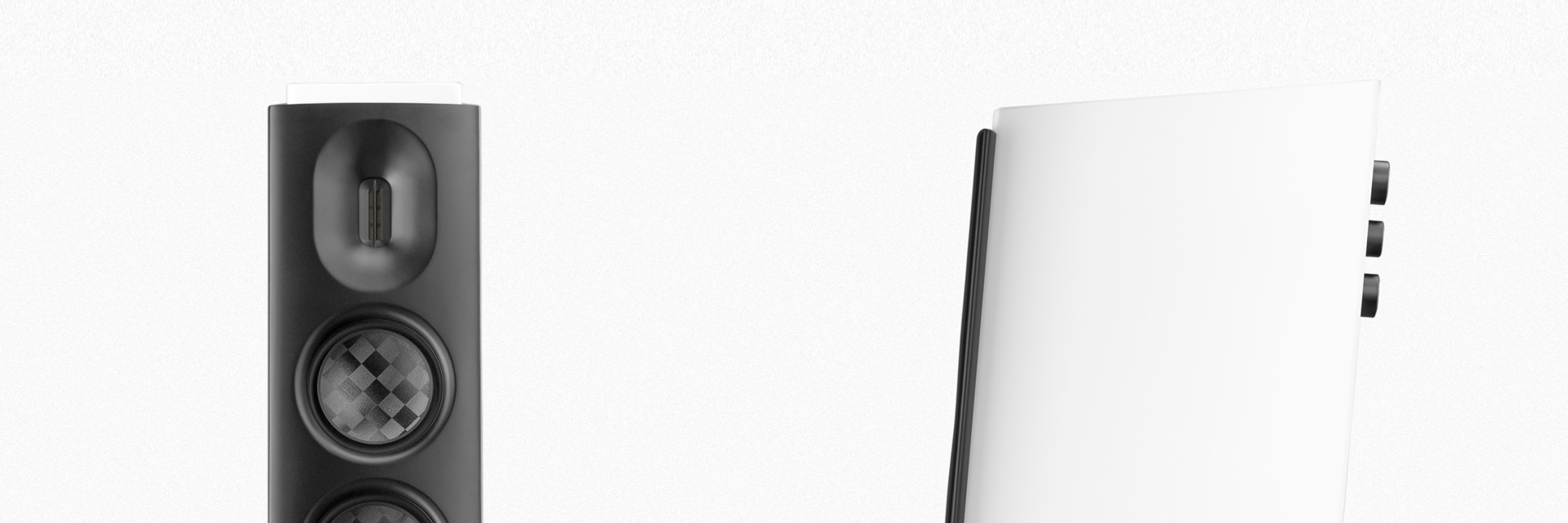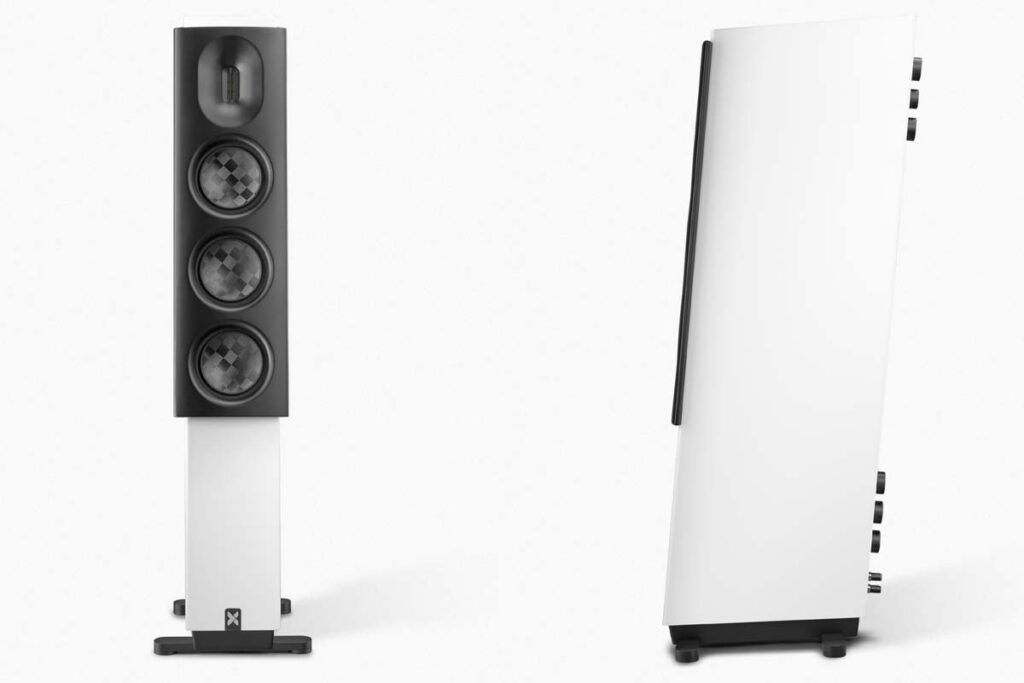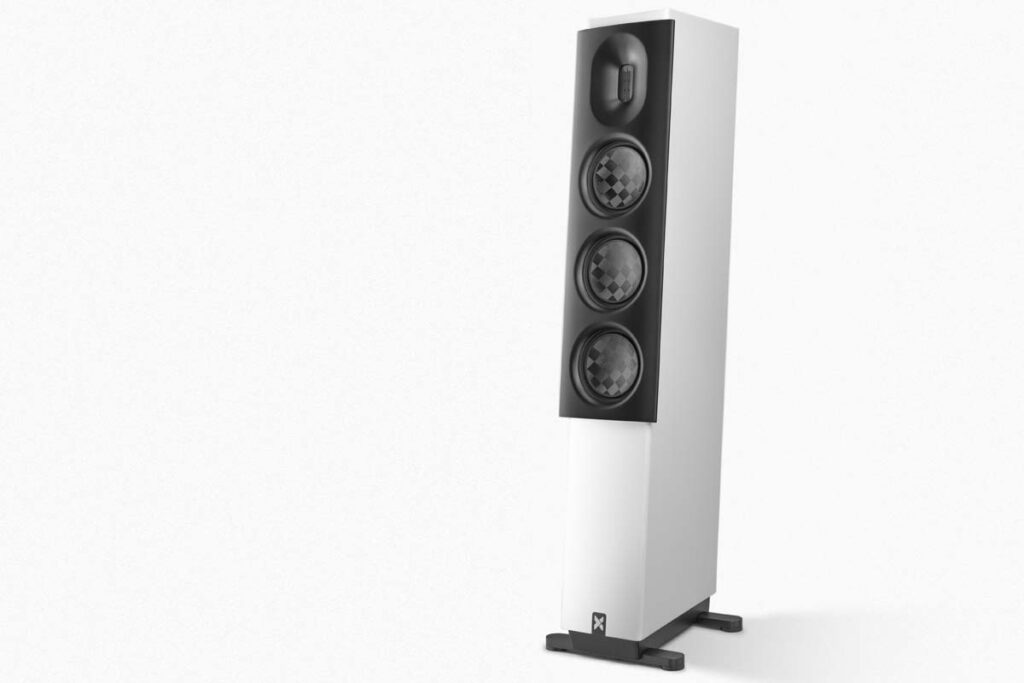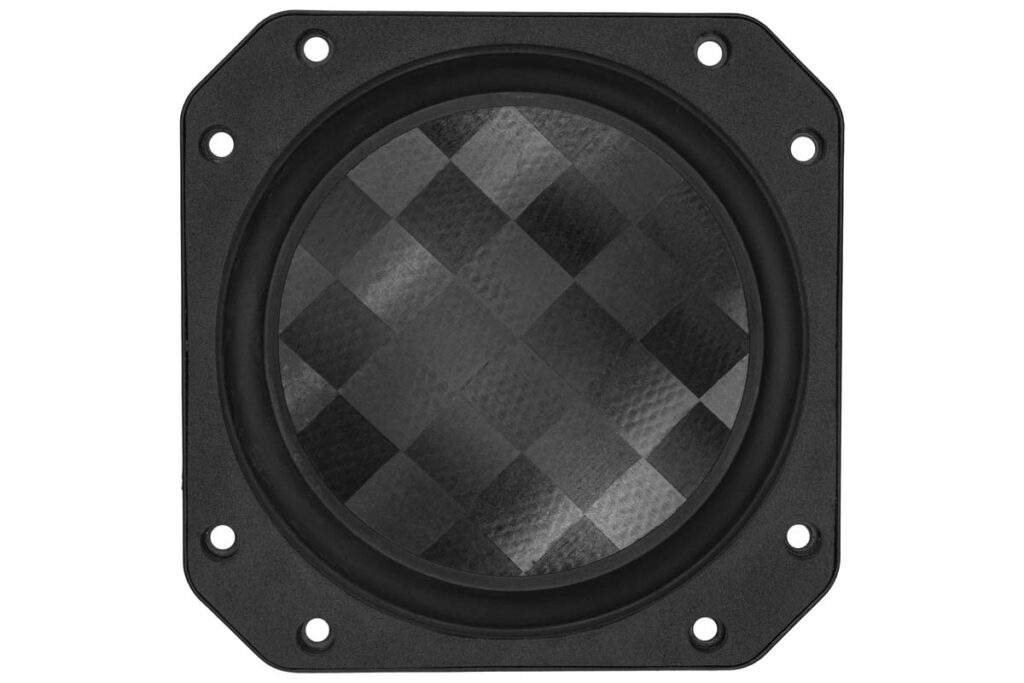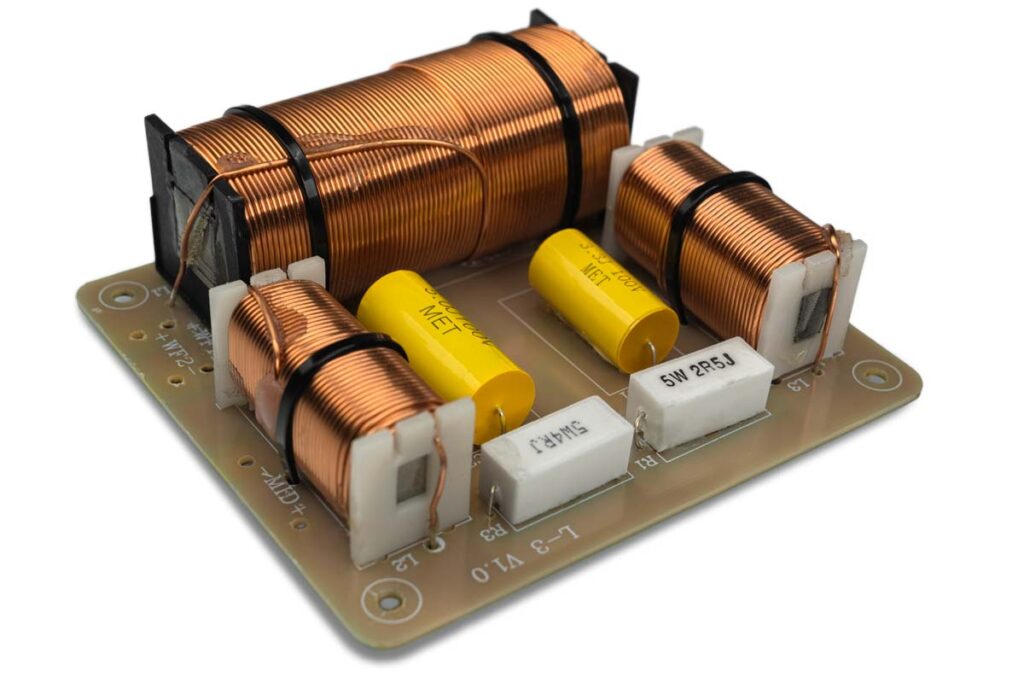In popular culture, Danes are said to place great value on honesty, but this is unquestionably true when it comes to the playback quality of the Axxess L3. Not forgetting that, to some extent at least, every audiophile creates their own personal truth.
When the editors asked me if I might be interested in reviewing the new L1 standmount speaker from Audio Group Denmark’s Axxess series, I immediately jumped at the chance. In addition to the soft spot I’ve always had for high-quality bookshelf speakers, I’d previously had zero hands-on experience with these Danish products, which only served to pique my curiosity even more. In joyful anticipation of receiving an easily maneuverable pair of speakers, I was somewhat surprised at what I actually found standing on my doorstep: a pallet with a 1.5 meter tall block wrapped in black stretch foil. After freeing the block from its wrapping, I was relieved to see that it was made up of four separate boxes that were relatively easy to carry. There were, however, no cute bookshelf speakers, just full-grown floorstanding models – the Axxess L3. The delivery bundle also included the Forté 3 streaming amplifier and Axxess speaker cables, making up a complete system.
Axxess is the name of a relatively new entry-level series from Audio Group Denmark. Although “entry-level” is certainly the correct designation within the context of this particular Danish company’s portfolio, the Axxess components could just as easily be the final stop on a buyer’s audiophile’s journey. On the company’s website, technical director Michael Børresen explains that the goal of the Axxess series was to transfer the core technologies of the Ansuz, Aavik and Børresen brands into a more affordable product group. The name Axxess is derived from “accessible”, and the components that emerged from this idea include streaming amplifiers, speakers and accessories. The affinity between the L3 floorstanding speaker and the elegant, elaborately designed Børresen loudspeakers (I almost wrote “boxes”, but that really doesn’t do them justice!) is immediately apparent.
The extremely narrow, tall and tapered cabinet clearly carries the signature of Michael Børresen, with additional influences from design advisor Flemming Erik Rasmussen, founder of Gryphon Audio. With its backward-tilted baffle and upward-sloping top, the L3 makes a sleek, almost dynamic impression. The six vent pipes protruding from the rear panel – a mere 7 cm in width – serve to reinforce this effect. If I equate “dynamic” with “a speedy response by the diaphragms”, then the appearance of the speakers’ certainly matches their acoustic properties – that much I can reveal upfront. The cabinet is stiffened by multiple cross-ribs and divided into three chambers. The lower one is shared by the two woofers, while the one above is used for the midrange driver, and also contains a separate volume for the ribbon tweeter.
In a long telephone conversation, Børresen explained the technical concept of the Axxess L3 to me. The upper compartment is essentially a two-way monitor, with the crossover point between the ribbon tweeter and the bass-midrange driver at around 2500 Hz. The low end is limited only by an appropriately tuned bass reflex port. Two identical drivers connected in parallel handle the low bass range, limited at the top by a single inductance. Børresen explained that this particularly high-quality C-core coil is normally only used in much more expensive loudspeakers, but simpler (cheaper) coils are unable to achieve the desired sound quality. This low-pass filter and the lower roll-off of the mid-high unit cleverly combine to attain the low crossover frequency of 80 Hz, effectively turning the bass section into an integrated subwoofer. Børresen is not a fan of complex crossovers that bog the speaker down in a variety of ways. Instead, he optimizes the chassis and cabinet so that they no longer require complex correction circuits.
Extensive damping of the cabinet volume using porous materials was also avoided – only the side walls are lined with thin and fairly dense insulating panels. The developer made it clear that he doesn’t consider resonance suppression inside the cabinet to be a top priority for good sound characteristics, believing that excessive damping chokes too much life out of the playback process. His approach is to prevent internal pressure waves and resonances from reaching the outside (in contrast to the design of classic BBC monitors, with typically thin cabinet walls that consciously permit vibrations).
Børresen achieves his goal by means of the fundamentally rigid geometry and the special material used for the cabinet. This composite material is considerably stiffer and denser than the MDF typically used in this price range. According to Børresen, there is one important effect that is typically underestimated or not taken into account at all: a portion of the sound escapes from the cabinet through the diaphragms, causing distortion. Less rigid diaphragms, such as paper cones, are particularly problematic in this respect. The three-layer cone he uses for the bass-midrange drivers consists of two layers of carbon fabric bonded together by an aramid honeycomb structure. Adapted from nature, this honeycomb structure creates maximum stability with minimum use of material.
The identical woofers and midrange drivers have inherited a number of features from Børresen’s considerably more expensive C and X series. According to the technical specifications, these are 4.5-inch cones, which was initially puzzling, as they looked more like 6.5 inches to me. A check with a folding rule confirmed the discrepancy. The explanation is that the Danish manufacturers specify the effective cone diameter, unlike the majority of vendors who boast about the diameter of the basket (these Danes clearly have no need to brag!). The drive unit also benefits from technologies filtering down from the more expensive series, such as the double copper pole caps ensuring high flux density and low inductance. In the lowest octaves, the woofers are supported by three bass reflex tubes. When I asked Børresen whether multiple slim tubes were used for anything other than aesthetic reasons, he replied that they are mainly there to prevent flow noise and resonances.
The ribbon tweeter has a Kapton (polymide) foil membrane on which thin conductive tracks have been printed. Compared to conventional domes, they have a lower mass and a larger membrane surface, both of which help minimize distortion. A cover is magnetically attached to the front of the housing. The sound guide milled into the cover helps make more effective use of the ribbon’s high-frequency energy and optimizes its dispersion characteristics. The openings for the midrange and woofer are also perfectly rounded. Together with the inverse surrounds, this ensures an interference-free transition to the baffle. The cover extends two centimeters beyond the edge of the housing, and this protrusion has a semi-elliptical cross-section. Børresen confirmed my assumption that this is intended to reduce edge diffraction of the sound waves. The narrower housing behind it means that the chassis can be screwed in at the corners, i.e. where the cabinet is at its stiffest.
The connection terminal is located at the bottom of the rear panel. Accepting banana plugs and spades, the two proprietary pole terminals make a very solid impression.
The L3 stands securely on two elegant aluminum crossbars, with round feet that allow the speakers to be height-adjusted using a fine thread. They can also be fitted with a specially designed Axxess Noir Resonance Control device (set of 4), but these were not available for this review.
Unboxing the speakers and setting them up was a breeze, and didn’t require more than one person. No assembly work was necessary – just place them where you want, plug in the cables and you’re done. I positioned the L3 in the place where, in my experience at least, the modes in my listening room have the least effect. Interestingly, this was roughly in line with the manufacturer’s recommendations. Right from the start, I was impressed by the stupendously sharp imaging and detail retrieval. However, the sound stage was still quite flat, and tonally, the presentation was leaning towards the brighter side of the spectrum. The low bass frequencies were powerful, with a good amount of pressure, and were fired quickly into the room, but the whole thing lacked homogeneity, as if each driver was playing its own music. I wasn’t surprised by this: the speakers made a brand-new impression and had probably not been run in yet.
An email exchange with Morten Thyrrestrup, Audio Group Denmark’s sales manager for Europe, confirmed my suspicions: he reckons that the speakers should have largely reached their full performance potential after 200 hours of operation. In the operating instructions, the development is depicted in the form of an exponential saturation curve, according to which the break-in phase is finally complete after 500 hours. The reason I am describing this in such detail is because I have rarely experienced such a dramatic improvement in sound characteristics as a result of the break-in process – after 10 days of continuous operation, the L3s had metamorphosized from a gray duckling into a magnificent swan.
To gain a first impression, I connected up the L3 to my system with the usual peripherals, before switching to the Forté 3 streaming amplifier and the Axxess speaker cables. The exceptionally open and clear reproduction across the entire sound range of the L3 was an exhilarating experience with both amplifiers. What also became clear, however, was the different characters of the Scandinavian neighbors. While the Norwegian pairing sounded somewhat more sonorous, the Axxess Forté 3 increased the precision in spatial and rhythmic terms into an addictive dimension. The representation of sonic events was almost startlingly realistic, both in terms of contour and timbre. Voices were holographic yet clearly delineated, without appearing larger-than-life, standing rock-solid in their assigned place. In conjunction with the sensational attention to detail, a level of speech intelligibility was achieved that made it easy for me to understand even totally mumbled vocal passages. High frequency resolution in particular left nothing to be desired, especially as it wasn’t achieved by lifting the treble. On the contrary, the presentation was smooth, homogeneous and natural without any artificial harshness. With good recordings, the soundscape was completely detached from the speakers.
These capabilities of the L3 created the fascinating impression of being right there at the performance. And this was achieved in a very special, almost delicate way – maintaining a certain distance to the stage, retaining an overview and yet feeling directly involved. Every style of music benefited from this, assuming I hadn’t picked out a particularly poor recording. In the case of the vinyl LP Unforgettable, A Tribute To Dinah Washington by Aretha Franklin – admittedly an excellent recording – the L3 revealed all the nuances of the Queen of Soul with astonishing clarity, along with the delightful wailing of the organ.
The double LP Chet Baker At Onkel Pö’s Carnegie Hall, recorded by NDR in Hamburg in 1979, brought the heated, rumbling atmosphere of the pub gig directly into my listening room. John Lee Hooker’s “Ain’t gonna Suffer No More” immediately transported me to the Mississippi Delta. The largely electronically generated sounds of Christine and the Queens were blasted at me with vigor and enormous enthusiasm. A totally convincing performance! I almost forgot to mention how classical and especially early music also benefit from the playback qualities described above. Even in complex passages with large orchestras, no detail is neglected, with precise integration into the overall work. Perfect spatial imaging completes the listener’s enjoyment.
The Axxess L3 is an extremely impressive example of technology transfer into more affordable realms. Manufacturing the cabinets in China and assembling the chassis in Taiwan has a positive effect on the pricing. In this connection, Børresen was careful to point out that all components used in the chassis (e.g. the surrounds manufactured by Dr. Kurt Müller in Krefeld) are delivered to Taiwan beforehand, and the assembly work alone is performed there. The workmanship is absolutely flawless and would give no cause for complaint even in a higher price range.
The L3 are fantastic speakers, uncritical in terms of placement and with an extraordinary sound quality that practically transcends price class distinctions and encompasses all music genres. Only those who prefer coziness to authenticity might be put off by the honesty of these loudspeakers.
Due to inaccurate information, I initially assumed that the retail price was 10,000 euros, and that’s an amount I would have found to be entirely reasonable. In view of its qualities, however, the actual purchase price of 5,000 euro for the Axxess L3 turns it into an absolute bargain.
Accompanying Equipment
CD player: Electrocompaniet EMC 1 MKV | Turntable: TW Acustic Raven GT2 | Tonearms: TW Acustic Raven 10.5“ and 9.5” | Cartridges: Skyanalog Reference, Clearaudio Concerto V2, Excalibur Platinum | Amplifiers: Electrocompaniet EC 4.8, Electrocompaniet EC AW250R, Lab 12 Melto2 | Loudspeakers: Audio Physic Spark on Solidsteel SS-5 | Power supply, cables: IsoTek Aquarius, Syncro and Optimum, AudioQuest Yukon and NRG-Z3, Zavfino Gold Rush, 2 x Kimber 8TC, WBT | Accessories: bFly-audio Octopus and PolarX, Audio Physic VCF V Magnetic plus, Lehmannaudio Stage 1 turntable mat, TW Turntable Mat, Sonic Voice, Nessie Vinylmaster
Loudspeaker Axxess L3
Concept: passive 3-way floorstanding loudspeaker | Driver complement: 1 x Axxess planar ribbon tweeter, 1 x Axxess mid-woofer (4.5“), 2 x Axxess woofers (4.5”) | Frequency response: 35 Hz to 22 kHz | Sensitivity @1 W: 88 dB | Impedance: > 4 Ω | Recommended amplifier power: 50 W | Finish: Black or white, silk matt | Dimensions (W/H/D): 30/125/41 cm | Weight: 30.2 kg | Warranty period: 2 years | Pair price: around €5,000
Audio Group Denmark
Rebslagervej 4
1000 Aalborg
Denmark
info@audiogroupdenmark.com

